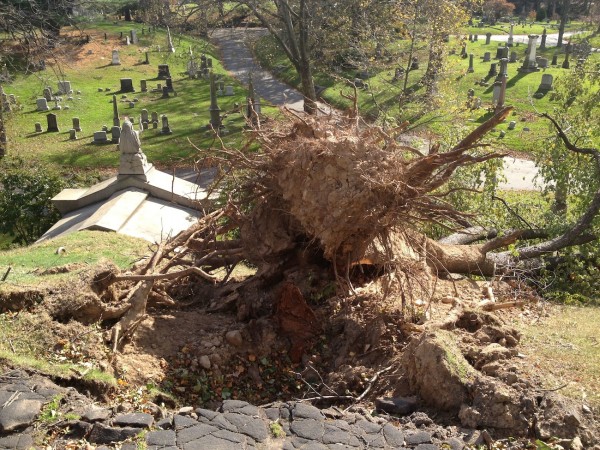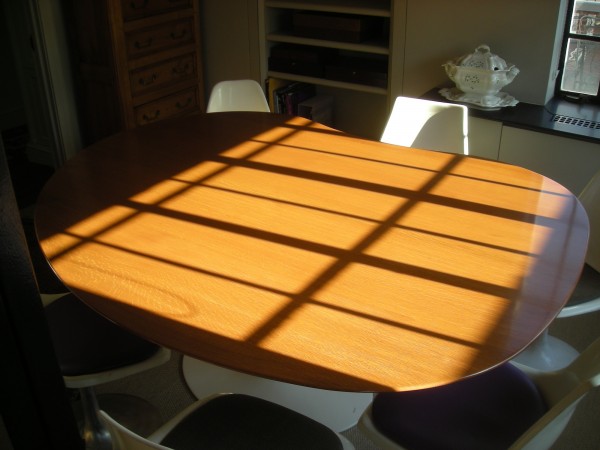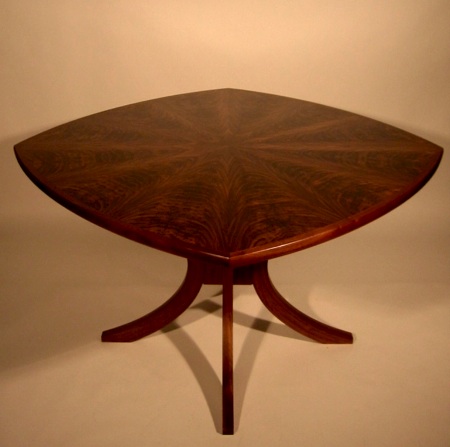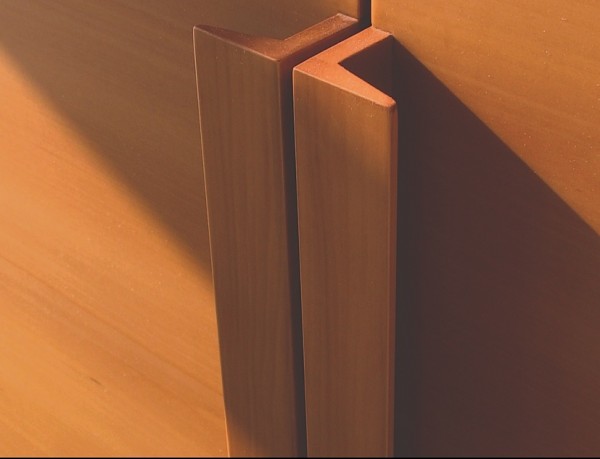As I reported in “Sandy Hammers Green-Wood,”our recent hurricane visitor was not kind to Green-Wood’s grounds. Approximately 300 mature trees–oaks, maples, beeches, and more, were toppled or snapped off. And, those tons of wood landed on more than 200 monuments, shattering angels and gravestones.

But it was not all a loss. In fact, it was a boon for one group: woodworkers. Cliff Rose, Green-Wood’s chief arborist, reports that several woodworkers have expressed an interest in beech, oak, Norway Maple, and linden. And, there are few limitations: “Currently we have no restrictions on the wood that is going out because we are not in the “Asian Long Horned Beetle” quarantine zone. They are limited only by what they can carry and the size vehicle that can safely move within Green-Wood. The wood does not necessarily have to stay in New York, but the Department of Agriculture and Markets likes to keep it within 50 miles.”
Peter Davis, who has a woodworking shop in Williamsburg, had his eye on Green-Wood and its 8000 mature trees even before Hurricane Sandy hit. Peter has worked in custom furniture and cabinetry for 14 years. In 1990, he moved to Windsor Terrace, and has since moved to Kensington–so he has been a Green-Wood neighbor for quite some time and has visited the cemetery several times a year. Earlier this year, Peter had gotten pieces from Green-Wood of a pin oak that had come down–good hard wood, to be turned while still green. And, after Hurricane Sandy hit, Peter saw a lot of wood down at Green-Wood that he could use. So he contacted Cliff Rose at Green-Wood about obtaining wood to be turned into bowls and other vessels, as well pieces to be crafted into furniture.

As Peter tells it, the destruction wrought by Hurricane Sandy presented a rare opportunity: “A lot of the trees come down at Green-Wood because they are mature trees. Those don’t exist anywhere else in these numbers in New York City.” Of course, there is a problem with some of the trees that fell to Sandy’s winds: they went down because they had grown both old and unhealthy, and their wood is therefore not very good. Or, their wood may have been good, but their crash to the ground put structural problems–cracks and checks–into the wood. But, given the number of trees that fell, there are still many good mature trees to choose from–some a century and more old. Peter is particularly interested in Norway Maples, Red Maples, Cherries, and Copper Beeches.

He has also spotted some great burls on Red Maples–and burls are what really get a wood turner’s juices (sap?) flowing. At this point, Peter has marked wood that he intends to pick up–when we spoke, he was looking for a boom truck large enough to load all the wood he wants.
There is also the issue of green wood (pun intended?). Wood that will be turned–for bowls and the like–is turned while still green–within a year of the tree’s death. But wood for furniture can’t be worked until after it has dried for two to three years. So some wood for now, some for a few years from now.
Richard Nonas is a sculptor in Tribeca. His good friend, Cesar Puello, wanted to do him a favor and get him some wood that he might sculpt. So he contacted Green-Wood, got the got-ahead, rented a car, and came out. He described what he wanted–pieces between two and three feet–and was led out to an area of the cemetery grounds where such pieces were plentiful. He filled up his vehicle and brought his friend the wood. That should keep him busy for a while!
Tony Visco also is a local Brooklyn woodworker. Tony has worked in Brooklyn for 11 years and has run his business, Ivory Build, for the past four years. He shares space in Sunset Park at Bush Terminal’s Industry City with other woodworkers. (A note: Irving Bush, who built Bush Terminal, is interred at Green-Wood at the intersection of Cypress and Beech Avenues. Notice that many of Green-Wood’s roads have tree names.) There Tony creates furniture, cabinetry, and architectural mill work.

Tony lives just two blocks from Green-Wood and walks by the cemetery’s main entrance every morning. He has been to Green-Wood as a tourist and could not help but notice all of the mature trees on the grounds. When Hurricane Sandy hit, Tony contacted Art Presson, Green-Wood’s superintendent, and asked if wood might be available. He was excited to learn that mature local lumber, very difficult to come by in Brooklyn, was indeed available for the taking.

So Tony has marked wood at the cemetery–oak, maple, and cherry–and is making arrangements to come into Green-Wood and mill it on the grounds, as well as to send some off to a friend who has a lumber mill upstate. Not unexpectedly, visions of large-slab tables and other pieces have been dancing in the creative minds of Tony and the other woodworkers with whom he will share this wood.
When I spoke with Tony, and explained that I wanted to interview him for a piece about some good coming from all of the trees that had been destroyed, he got the point immediately: “One door closes, another door opens.”
Yes, even from a disaster of the scope of Hurricane Sandy, hope can be born.
Wonderful that those trees came to a good
use. The results of Toni’s work is superb
Many thanks to all on the Greenwood staff
for the excellent job in bringing this
information to us readers
Regards from
Maurice Bergman
Breitbrunn am Cheimsee
Germany
If our permanent resident famous cabinet maker Duncan Phyfe was alive, he would be in his glory with all this beautiful wood. It eases the pain a little to know that the wood will be used to make beautiful furniture and artistic pieces.
Marge Raymond
Official Green-Wood Historic Fund Tour Guide
Peter Davis will make remarkably beautiful works of art of of the Greenwood lumber. I have several pieces by Peter and they are the highlight of my collection.
I am looking forward to seeing the work he produces from the Greenwood trees.
Arlene Norman